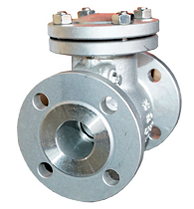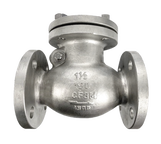|
|
Swing check valves are also known as one-way or non-return valves. They are made following the ANSI B16.34 standards. Swing check valves allow the passage of fluid (liquid or gas) in a single direction. They also aid the maintenance process of systems and avoid the issue of backflow. It has a directional marking stamped on the body to enable easy installation of the valve. Swing check valves are made from stainless steel and brass material and available in sizes ranging from 1/2” to 4” for brass and 1/4” to 2” for stainless steel. The working pressure is rated between 200 PSI to 300 PSI and connection types NPT and BSPT. Alternatively, Limit switches are incorporated into the valves for remote monitor control. |
Material Specification |
|
Connection Type |
|
Size |
|
Working Pressure |
|
Swing Check Valves Specifications
To learn more about individual product specification, please read the details below:
1. What is a Swing Check Valve?
|
Swing check valves are special check valves that help prevent backflow in a line. They are designed after the ANSI B16.34 standards. The swing check valve is a low pressure valve designed with features to give an easy opening at low velocities, unlike other check valves types. Swing check valves are also known as one-way or non-return valves and they can be applied in horizontal or vertical pipelines. They are designed in sizes from 1/2” to 4” and 1/4” to 2” for brass and stainless steel check valves respectively. They are made from brass and stainless steel materials.
|
2. What are the types of Swing Check Valves?
Swing check valves are produced in different types. The available swing check valves are ANSI 150# SS316 swing check valve, JIS 10K SS316 swing check valve, threaded end SS316 swing check valve, ANSI 150# cast steel swing check valve, and threaded end brass swing check valve. There are made of different material components according to application.
|
ANSI 150# SS316 Swing Check Valve:
The ANSI 150# SS316 Swing Check Valves are one-direction valves made in the BS1868 ASME B16.34 standards. The working pressure of 150# comes with sizes range from 1 1/2” to 4”. They are generally applicable in oil, gas, and water systems. The table on right shows the material information of the valve: |
|
|
Threaded Brass Swing Check Valves:
It is a threaded end swing check valve and NPT as an end connection. It is made from brass or stainless steel, SS316 / SCS14A. The check valves work with a pressure up to 300 psi and available in sizes from 1/2” (DN15) to 4” (DN100). The table on right shows the body materials of the brass swing check valve: |
|
|
ANSI 150# Cast Steel Swing Check Valve:
The swing check valve is available in flange end connection. These valves are made from cast steel material. With a maximum working pressure of 150 PSI, the swing check valves are available in sizes ranging from 1 1/2” to 6”. Please refer to the table on right for the breakdown of materials for the valve: |
|
3. Why do Swing Check Valves slam?
|
A swing check valve depends on backflow and gravity to effectively shut-off. The slam effect of check valves happens during pump shutdown because the backflow and gravity hit the check valve shut, thereby, causing the forceful loud noise. Non-compressible fluids could also result in a water hammer, shock, or pressure wave.
Slamming for check valves is a harmful occurrence for pipes and other attached equipment as it creates crucial pressure surges. Looking at the root cause of slamming, poor sizing or selection is a factor and the following should be considered to avoid this occurrence:
|
4. Will a check valve stop water hammer?
|
Water hammer happens when water flowing through the pipes is suddenly forced to terminate or shift the direction. The fluid supply is kept at high pressure, and the fluid can flow through the pipeline easily. When fluid flowing stops suddenly, a water hammer happens because a tap is turned off or a valve on an appliance shuts, and the pressure trap air creates a shock wave.
A water hammer or liquid hammer is a recurring problem accrued to check valves in systems. This is caused by high pressure waves popping up in incompressible fluids when the flow of fluids abruptly ends or direction alteration. This is a problem that could lead to damage to the pump and the valve itself. It also leads to extreme noise and vibration. In worst cases, a pipe and system downfall is inevitable. |
5. When would you use a Swing Check Valve?
|
Swing check valves have a distinct effect it has when in use. They help prevent backflow mainly and serve other purposes like maintaining the flow of fluids in pipelines. These tubes are mainly used for heating, ventilating, and air conditioning (HVAC) devices, particularly in tall buildings. The significance of swing check valves in this installation is to prevent the backflow of the cooling substance.
Maintaining a swing check valve is very easy once the bolts (hinge and disc) are detached. The disc is fixed in the hinge pin, which gives easy movement (horizontally and vertically) and tightness against filths when closed. The seat of the valve is also installed at a 20⁰ angle, which gives extra tightness. The hinge is corrosion resistant due to its material (stainless steel) and gives durability. It can also be reversely placed to maximize space. |
Some of the advantages of using swing check valves are as follows:
- Lightweight disc reduces the force needed for valve operation.
- Bonnet and disc part allow the maintenance and repairs easily carried out
- Movement of disc both vertically and horizontally ensures close tightness to prevent leakages
- Smooth and unrestricted flow of fluids during operation.















